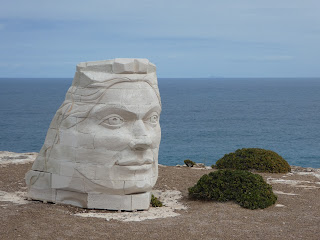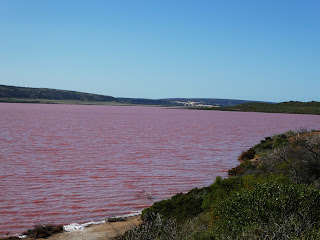Avoiding the flooding in some rivers across central western
NSW was not really too difficult, although we did have to make a detour when
the road between Grong Grong and Matong was cut . . . aren’t they wonderful
Australian place names? Our route included Junee, which we have visited before,
so we knew exactly where to go – the chocolate and liquorice factory,
particularly to stock up on their chocolate-coated raspberry liquorice, and
chocolate-coated inca berries.
We spent a happy night in Cootamundra, where the creeks were
running well, then made our way to Canberra via the historic town of Harden,
where we watched a whole crew of chaps sprucing up the railway station,
painting the white line along the edge of the platform. This took four of them,
one to push the spray machine, one to direct the nozzle onto the platform edge,
and two bringing up the rear with paint rollers. Sadly, it was a very windy
day, and the masking tape they’d so carefully laid on the edge of this white
stripe obviously didn’t adhere, as it started lifting and then flying around.
At that point, we left them to it and sought a nice hot coffee in a suitably
warm café.
The country around Canberra is looking fabulous . . . all
green pastures, snowy sheep and golden canola. While staying with John’s family
there we were taken to see the Cotter Dam, which had had its dam wall raised
quite dramatically in recent years. The dam is so full that water was cascading
from a huge height over this high wall. Elsewhere the Scrivener Dam, which
regulates the water level in Lake Burley Griffin, was also spilling
dramatically.
But the rain followed us, as well as windy, cold weather, so
even on the day we left Canberra to start driving north, it was not at all
pleasant. We turned sharply north at Goulburn . . . after delighting in the
sight of Lake George actually filling with water after what the locals say is
about 20 years. Whenever I’ve seen it before it is just pasture for sheep and
cattle.
Anyway, we drove north to Oberon, detouring briefly to check
out the Wombeyan Caves, which have now joined our favourite places in WA and SA
as ‘must return’ locations. The wind was howling in from the west, making the
rain almost horizontal, and cattle were pressed against fences with
their rear
ends to the cold wind, and their faces looking most miserable. Little lambs were huddling with their Mums
and even the alpacas in some of the paddocks we passed were looking fairly
cheesed-off at the weather.
 |
One of the many historic buildings in Ryleston.
|
We kept heading north towards Mudgee, but turned into the
Bylong Valley, stopping for the night at Rylstone, where the Apex Club had
built a small caravan park. The young local woman who has the management rights
from the council came around almost on dark to collect camping fees and told us
that as it’s a long weekend she is just about booked out for the next few
nights.
We’ll move on to Scone to visit some of John’s friends, then
have our final night on the road at Glencoe, visiting my late sister’s daughter
and her family . . . then it’s a final sprint to HOME.
.
|
We’ve driven more than 21,000 km in three months, seen
wonderful sights and met some fabulous new friends, but we are looking forward
enormously to returning home. We have done so much our brains have almost gone
into information overload, so it will be wonderful to reflect on everything
we’ve learnt about this huge and varied country of ours.
And with the effects of rain visible everywhere from the
time we started our journey until now, we have never seen the Outback looking
so good. And the crops of wheat and canola we’ve seen from WA to NSW really do
make it a green and gold nation.
Thank you all for taking the journey with us. I wish all
Australians could see what we have: The dust, the gorges and the mining wealth
of the Pilbara; the glory of the WA wildflowers; the majesty of mountains in
many states from the Flinders Ranges to the Bylong Valley in NSW; and the
life-giving blessing of good rain.












































